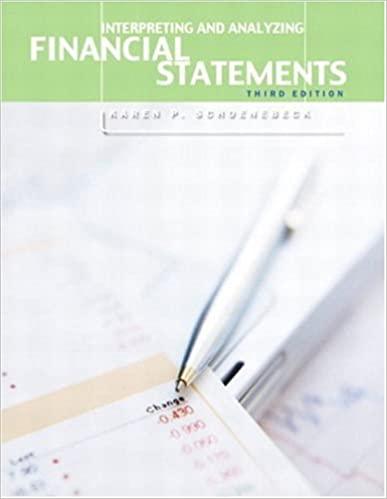Question
1.The following data pertain to an investment that is being considered by the management of Hanson Company: Discount rate 9% Life of the project 6
1.The following data pertain to an investment that is being considered by the management of Hanson Company:
| Discount rate | 9% |
| Life of the project | 6 years |
| Cost of the investment | $38,131 |
| Annual cost savings | 8,500 |
| Salvage value | 1,700 |
The net present value of the proposed investment is
2.Hamell Company has gathered the following data on a proposed investment project:
| Discount rate | 10% |
| Life of the project | 10 years |
| Initial investment | $430,000 |
| Annual cash inflows | 83,000 |
| Salvage value | 0 |
The net present value on the proposed investment is closest to
3.In comparing two investment alternatives, the difference between the net present values of the two alternatives obtained using the total-cost approach will be:
a.indeterminable.
b.the same as the net present value obtained using the incremental cost approach.
c.greater than the net present value obtained using the incremental cost approach.
d.less than the net present value obtained using the incremental cost approach.
4.Acme Company is considering investing in a new machine that costs $56,500 and that has a useful life of 10 years with no salvage value. The machine will generate $10,000 annually in net cash inflows. The internal rate of return on the investment is:
5.A project with a 8-year life has tangible costs and benefits with a $165,000 negative net present value. The companys discount rate is 9%. The amount of annual cash inflow would have to be provided by the projects intangible benefits in order for the project to be acceptable is
6.A project with a 8-year life has tangible costs and benefits with a $123,000 negative net present value. The companys discount rate is 10%. The amount of annual cash inflow would have to be provided by the projects intangible benefits in order for the project to be acceptable is
7.Hartley Company is considering the following investment proposals:
| A | B | C | D | |
| Investment required | $160,000 | $200,000 | $120,000 | $150,000 |
| Present value of future net cash flows | 192,000 | 300,000 | 168,000 | 240,000 |
Management should rank the proposals in terms of preference using the profitability index as:
8.The preference rule for ranking projects by the profitability index is:
a.the higher the sunk cost, the more desirable the project.
b.the higher the profitability index, the more desirable the project.
c.the lower the sunk cost, the more desirable the project.
d.the lower the profitability index, the more desirable the project.
All of the following statements are incorrect except:
a.projects with shorter payback periods are always more profitable than projects with longer payback periods.
b.the payback period is the length of time it takes for an investment to recoup its own initial cost out of the cash receipts it generates.
c.if new equipment is replacing old equipment, any salvage received from sale of the old equipment should not be considered in computing the payback period of the new equipment.
d.the payback method of making capital budgeting decisions gives full consideration to the time value of money.
10.Hamell Company has gathered the following data on a proposed investment project:
| Discount rate | 9% |
| Life of the project | 9 years |
| Initial investment | $291,100 |
| Annual cash inflows | 71,000 |
| Salvage value | 0 |
The payback period for the proposed investment is closest to
11.Hamell Company has gathered the following data on a proposed investment project:
| Discount rate | 8% |
| Life of the project | 8 years |
| Initial investment | $390,000 |
| Annual cash inflows | 76,050 |
| Salvage value | 0 |
Assume that excess of incremental revenues over the incremental expenses (including depreciation) equal the annual cash inflows. The simple rate of return on the proposed investment is closest to: (Round your answer to 1 decimal place.)
12.A machine is under consideration that would cost $23,800, save $5,400 per year in cash operating costs, and have an expected life of 14 years with zero salvage value. The simple rate of return is approximately: (Round your answer to 2 decimal places.)
13.White Companys required rate of return and discount rate is 11%. The company is considering an investment that would yield a cash inflow of $11,000 in six years. The maximum amount that the company should be willing to invest in this project is (Round your intermediate calculation to 3-decimals and final answer to the nearest dollar amount.):
14.Farris is considering making an investment now that is expected to return $61,000 in six years from now. Farris demands a 10% return. The maximum amount that Farris should be willing to invest in this project is (Round your intermediate calculation to 3-decimals and final answer to the nearest dollar amount.):
15.Ignore income taxes in this problem.) The Jackson Company has invested in a machine that cost $230,000, that has a useful life of twelve years, and that has no salvage value at the end of its useful life. The machine is being depreciated by the straight-line method, based on its useful life. It will have a payback period of eight years. Given these data, the simple rate of return on the machine is closest to
3.12%
4.55%
4.17%
20.83%
Step by Step Solution
There are 3 Steps involved in it
Step: 1

Get Instant Access to Expert-Tailored Solutions
See step-by-step solutions with expert insights and AI powered tools for academic success
Step: 2

Step: 3

Ace Your Homework with AI
Get the answers you need in no time with our AI-driven, step-by-step assistance
Get Started


